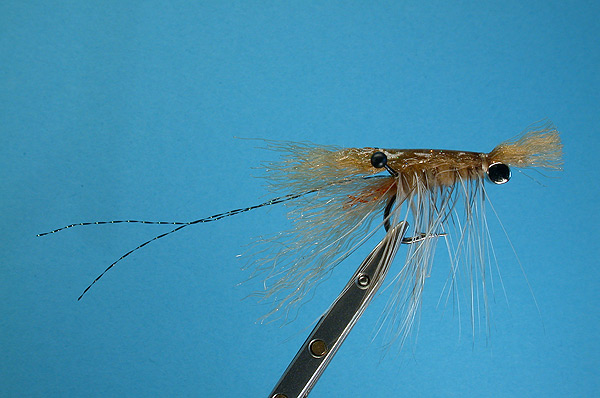Branham’s Epoxy Shrimp (and its Variations)

Note:
The best sizes for bonefish are 4 and 6. Larger sizes are good for other species. The best colors are: tan, clear with either a white or gray underbody, olive, and brown. Use the size and colors that imitate the shrimp in the area that you are fishing.
Variations:
Redfish Shrimp
Tied the same as the Epoxy Shrimp. Buck tail is used in place of the synthetic hair. The shell back can be coated with epoxy, silicone or Dynaflex 230. I prefer the Dynaflex as it is water based, easier and cleaner to work with than epoxy or silicone. The same colors as for the Epoxy Shrimp are the best but adapt the colors to the shrimp in the area that you are fishing.
Crayfish
Tied the same as the Epoxy Shrimp except that buck tail is used. This fly is tied on a long shank hook. The best color is an olive. Use the size and color that works in your area. I prefer the Dynaflex for the shellback.
History:
During the early 1990’s Bob Popovics developed the firs effective epoxy shrimp pattern called the “Ultra Shrimp”. Along the same time frame, Eric Peterson developed his “Walking Shrimp” which used natural materials and was an extremely effective shrimp pattern. What I did was to take the best of both patterns and develop it into a different “Epoxy Shrimp”. I also added bar bell eyes on the finished epoxy version.
I used the basic design of both patterns but used Ultra Hair as the shellback coated with epoxy, added a body of chenille or dubbing, 2 strands of black crystal flash as the antenna, an inverted “V” shaped weed guard tied slightly I front of the point of the hook and bar bell eyes to add weight.
I did not feel that I had really developed a new and original pattern but others thought it was different enough and started crediting it to me.
This pattern proved to be an exceptional fly for bonefish in the tan and clear/gray color. I received numerous letters, emails and phone calls telling me how the bonefish took this fly when they were not taking any other fly. One of the best areas for this pattern was the Bahamas. It was a “Killer” pattern in that area.
Over time, I needed a bigger shrimp for redfish. I made a larger version of the Epoxy Shrimp but with the epoxy, it made the fly very heavy. Some people were also hesitant to work with epoxies so, I started using buck tail as the primary material in lieu of the Ultra Hair and coated the shellback with silicone. People were more likely to use silicone than epoxy so this was a good material to work with.
Since that time, I have discovered another coating that is even better than silicone. It is made by DAP. It is DYNAFLEX 230; a water based sealant that is very easy to work with and cleans up with water. The sealant is milky when first used but dries transparent. The DYNAFLEX is also extremely durable. It is primarily used for sealing around exterior doors and windows and is paintable. This is an extremely good material to work with. It is available in all major home improvement centers.
As a Fly Designer for Umpqua Feather Merchants, I need to come up with new flies from time to time. The Redfish Shrimp was another fly that Umpqua took to produce.
I was talking to Lefty one evening and he told me that he and Bob Clouser were going fishing for small mouth bass and were going to use some crayfish patterns. A light went off and I saw that my Redfish Shrimp could be tied in smaller sizes and a different color and used as a crayfish pattern. I told Lefty that I wanted him to test a new crayfish pattern that I had and what was the best color and size to tie them in. Lefty told me to tie them in a size 4 long shank hook and in an olive color. Thus was born my “Crayfish” pattern. NOTE: Umpqua has this pattern under contract but ties it in a burnt orange color. I do not understand the color of this fly as the only crayfish that I have seen that is that color are the ones that have been cooked.
As a further spin off of the original pattern is a “Baby Lobster” that I developed for use in the North East. It is tied the same as the Redfish Shrimp. It is tied in sizes 2 to 1/0. The coloration of the “Baby Lobster” are a white belly ribbed with 2 strands of pearl crystal flash. The forelegs, mouth, head and shellback are tied using a blackish green buck tail. I generally use the outside (darker) hairs of a buck tail that has been dyed a medium to dark green. I have never promoted this pattern so it has fallen but the wayside.
It is surprising how one pattern can lead to as many variations as this fly has become. Take this pattern, adapt it to your fishing areas and see what happens.